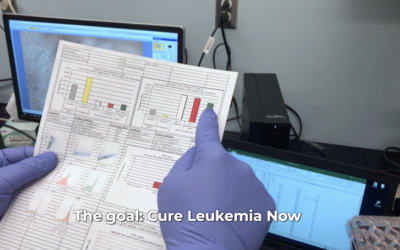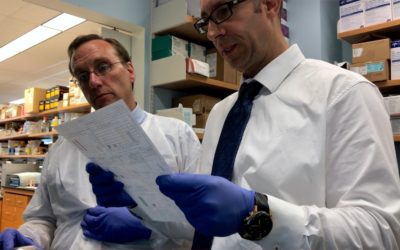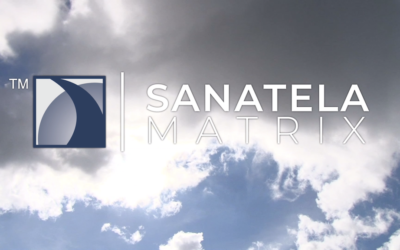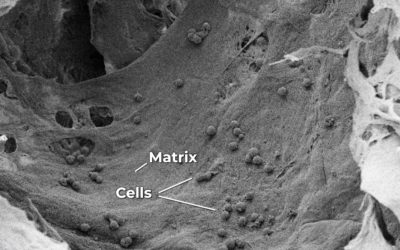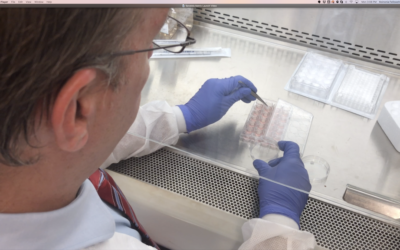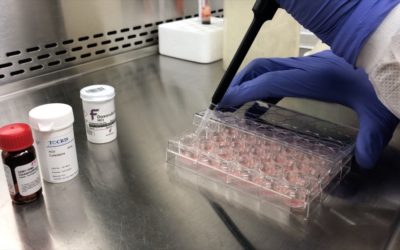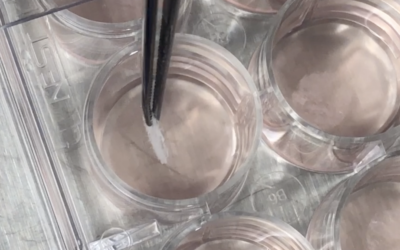What is the SanatelaTM Matrix?
Individualized medicine that is ready to go, right now
A Matrix is made from Wharton’s Jelly, the gelatinous connective tissue that surrounds and supports blood vessels in an umbilical cord. It contains an abundance of all the key components of the extracellular matrix, the three-dimensional network of proteins, enzymes and other macromolecules that provide structure and biochemical support to cells. It also contains a number of substances that stimulate cell growth and replication.
To bioengineer a Matrix, Wharton’s Jelly is first separated from an umbilical cord, then decellularized, homogenized, shaped and freeze-dried (lyophilized). The steps of this patented process vary depending on what the Matrix will be used for: screening cancer treatments, growing cells in a culture (including stem cells), regenerating tissue to treat defects and wounds, or forming complex tissues and organs.
The completed Matrix retains all of the key components of the extracellular matrix found in Wharton’s Jelly, uniformly distributed. The 3D structure is also maintained, enhanced by uniform pore size and distribution.
What can the Sanatela Matrix be used for?
The Matrix is a scaffold on which doctors and scientists can recreate natural environments found in the human body to support and expand any type of cell population, including stem cells. Cells of many types can be cultured in vitro on the Matrix.

The Matrix is currently being evaluated as a platform to screen cancer treatments, starting with leukemia. It is a 3-dimensional microenvironment that imitates the bone marrow “niche,” enabling and regulating the ability of Hematopoietic Stem and Progenitor Cells (HSPCs) to renew themselves. This novel in vitro culture system is based on Decellurized Wharton Jelly Matrix (DWJM) isolated and processed to form an extracellular matrix (ECM) scaffold. Researchers can then apply chemotherapies and other cancer treatments and test their effectiveness in an environment similar to bone marrow.
Leukemia stem cells are thought to support leukemia survival. They are an intense focus of research, but to study them researchers have to recreate the environment in which they live and function – the bone marrow (BM) hematopoietic “niche”. This niche also supports the HSPCs that are formed soon after conception, starting out in the yolk sac and eventually moving to the bone marrow of mammals, where it provides the protection and signals necessary to carry out the differentiation of normal blood cells.
The Matrix also provides structural and biochemical support to expand HSPCs like Umbilical Cord Blood (UCB) CD34+ cells, which seem to be attracted to the Matrix.
Publications
Li D; Lin TL; Lipe B; Hopkins RA; Shinogle H; Aljitawi OS. “A novel extracellular matrix-based leukemia model supports leukemia cells with stem cell-like characteristics.” Leukemia research. 2018;72():105-112.
Li D, Chiu G, Lipe B, Hopkins RA, Lillis J, Ashton JM, Paul S, Aljitawi OS. “Decellularized Wharton jelly matrix: a biomimetic scaffold for ex vivo hematopoietic stem cell culture.” Blood advances. 2019 Apr 9; 3(7):1011-1026.
How can we use the Matrix to treat cancer?
Dr. Aljitawi: Yes. How? There are two steps. The first step is by culturing own patient's cells in this matrix, we'll be able to understand them better in a model that reflects how these cells interact with the extracellular matrix in the human body. By understanding...
How do you use the Matrix to screen cancer treatments?
Dr. Aljitawi: For cancer screening, the first step is to grow the cancer cells in their natural environment, mimicking as close as you can the environment where they live in the human body. Our Matrix provides this type of environment. After you culture the...
Why is it critical to isolate cancer stem cells and work on them?
Dr. Aljitawi: So from a physician perspective, who treats cancer patients, especially in leukemias, we know that to be able to cure leukemia, you have to get rid of the leukemia stem cells, because in many cases we treat patients and we get rid of the...
Why is the Matrix an ideal environment to screen cancer treatments?
Dr. Aljitawi: This Matrix has many properties of the natural matrix that's present in the human body. So it's more natural and it probably captures as close as it can be to what happens in terms of interactions in the human body between cancer cells and the...
How do you know one therapy was more effective than another?
Dr. Aljitawi: So the way we can tell if it's more effective is by adding a particular drug to the cells that are interacting with this Matrix. If we see more of the cells dying, but also we can see other effects of the interaction of these cells with the Matrix; if...
How does the Matrix enable the individualized treatment of cancer?
Dr. Aljitawi: Currently there is no standardized model that we can use in the lab to predict the response in humans. So what we do is we treat all patients the same way. So treat them the same with the same chemotherapy and then find out which ones respond,...
When will the Matrix be in general use for patients?
Dr. Aljitawi: The first step is we have to make the Matrix in a very standardized way, so that Matrix A, B or C all have the same components, which potentially is very achievable. The second process is to generate data showing the effectiveness of this Matrix...
Read More About Sanatela's Pipeline
Amazingly, helping screen effective treatments for cancer is just one of many ways the Sanatela Matrix will make a transformative impact. Its ability to attract “normal” skin stem cells and give them the perfect environment to grow new tissue has many exciting medical applications.
